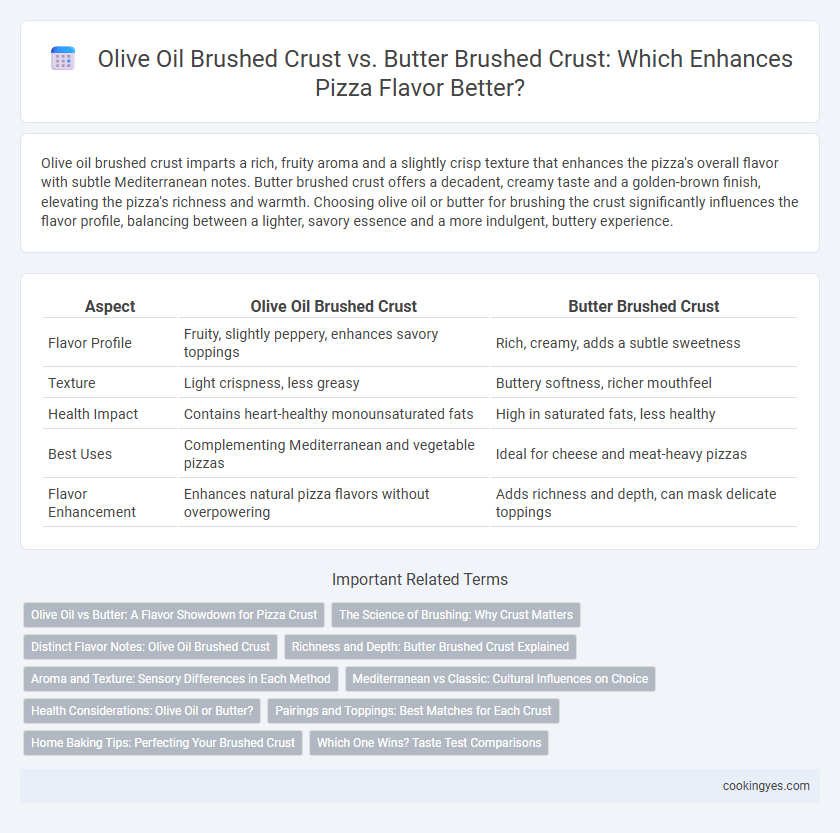Olive oil brushed crust imparts a rich, fruity aroma and a slightly crisp texture that enhances the pizza's overall flavor with subtle Mediterranean notes. Butter brushed crust offers a decadent, creamy taste and a golden-brown finish, elevating the pizza's richness and warmth. Choosing olive oil or butter for brushing the crust significantly influences the flavor profile, balancing between a lighter, savory essence and a more indulgent, buttery experience.
Table of Comparison
| Aspect | Olive Oil Brushed Crust | Butter Brushed Crust |
|---|---|---|
| Flavor Profile | Fruity, slightly peppery, enhances savory toppings | Rich, creamy, adds a subtle sweetness |
| Texture | Light crispness, less greasy | Buttery softness, richer mouthfeel |
| Health Impact | Contains heart-healthy monounsaturated fats | High in saturated fats, less healthy |
| Best Uses | Complementing Mediterranean and vegetable pizzas | Ideal for cheese and meat-heavy pizzas |
| Flavor Enhancement | Enhances natural pizza flavors without overpowering | Adds richness and depth, can mask delicate toppings |
Olive Oil vs Butter: A Flavor Showdown for Pizza Crust
Olive oil brushed crust infuses pizza with a fruity, slightly peppery aroma that enhances the dough's natural tang, creating a Mediterranean-inspired flavor profile. Butter brushed crust offers a rich, creamy taste with a subtle sweetness that adds depth and a golden, crispy texture to the edges. Choosing olive oil emphasizes a lighter, aromatic crispness, while butter delivers indulgent richness, making the choice pivotal for personalized flavor enhancement.
The Science of Brushing: Why Crust Matters
Olive oil brushed crust enhances pizza flavor by providing a rich, fruity aroma and a crisp texture due to its high monounsaturated fat content and antioxidants. Butter brushed crust offers a creamy, savory taste with a tender bite, attributed to its saturated fat and milk solids that caramelize during baking. The choice between olive oil and butter impacts Maillard reactions and moisture retention, directly influencing the crust's flavor complexity and mouthfeel.
Distinct Flavor Notes: Olive Oil Brushed Crust
Olive oil brushed crust imparts a rich, fruity, and slightly peppery flavor that enhances the overall taste profile of the pizza. Its subtle herbaceous notes complement tomato sauce and fresh mozzarella, creating a balanced and savory bite. This natural, Mediterranean oil also adds a crisp texture and a gourmet touch compared to butter's rich, creamy flavor.
Richness and Depth: Butter Brushed Crust Explained
Butter brushed crust enhances pizza flavor by adding a rich, creamy depth that olive oil cannot replicate, creating a luscious mouthfeel and golden-brown finish. The milk fats in butter contribute to a slightly sweet, savory richness that intensifies the overall taste experience. This method elevates the crust's texture with a tender, flaky quality, making each bite more indulgent and flavorful.
Aroma and Texture: Sensory Differences in Each Method
Olive oil brushed crust imparts a rich, fruity aroma with a slightly crispy texture that enhances the pizza's overall flavor profile. Butter brushed crust offers a creamy, savory scent along with a tender, flaky texture that adds a comforting richness. Sensory differences between these methods significantly influence the pizza's taste experience by emphasizing either a bold, aromatic finish or a smooth, buttery softness.
Mediterranean vs Classic: Cultural Influences on Choice
Olive oil brushed crust enhances pizza with a rich, fruity flavor that reflects Mediterranean culinary traditions, providing a healthier, aromatic alternative rich in monounsaturated fats. Butter brushed crust offers a classic, creamy taste typical of American and European pizza styles, contributing a savory richness and tender texture due to its saturated fat content. Cultural influences dictate these choices, with Mediterranean regions favoring olive oil for its health benefits and distinct flavor, while classic Western pizza recipes rely on butter to achieve a comforting, indulgent profile.
Health Considerations: Olive Oil or Butter?
Olive oil brushed crust enhances pizza flavor while providing heart-healthy monounsaturated fats and antioxidants like vitamin E, supporting cardiovascular health. Butter brushed crust adds a rich, creamy taste but contains higher levels of saturated fats and cholesterol, which may increase the risk of heart disease when consumed excessively. Choosing olive oil for crust brushing offers a healthier option with beneficial nutrients that align with dietary guidelines promoting heart health.
Pairings and Toppings: Best Matches for Each Crust
Olive oil brushed crust pairs excellently with Mediterranean toppings such as artichokes, olives, sun-dried tomatoes, and fresh herbs like basil and oregano, enhancing savory and herbaceous notes. Butter brushed crust complements rich, creamy toppings like mozzarella, mushrooms, garlic, and caramelized onions, adding a subtle sweetness and silky texture that enriches the overall flavor. Choosing between the two depends on whether the pizza toppings lean towards bright, bold Mediterranean flavors or indulgent, earthy ingredients.
Home Baking Tips: Perfecting Your Brushed Crust
Olive oil brushed crust enhances pizza with a rich, fruity aroma and a slightly crisp texture that complements savory toppings and offers health benefits like antioxidants. Butter brushed crust provides a golden, tender finish with a subtle sweetness that enriches the dough's flavor and creates a soft, flaky bite. For home baking, use olive oil for a robust, Mediterranean-inspired flavor, while butter suits traditional, buttery notes; brushing the crust before baking locks in moisture and ensures even browning.
Which One Wins? Taste Test Comparisons
Olive oil brushed crust delivers a rich, fruity flavor with a slightly peppery finish that complements savory pizza toppings, while butter brushed crust offers a creamy, buttery taste that enhances the crust's golden, crispy texture. Taste tests often reveal that olive oil provides a more balanced and robust enhancement, elevating the overall pizza experience without overpowering other ingredients. For those seeking a healthier option with heart-healthy fats, olive oil crusts are the preferred choice, whereas butter appeals to those craving a decadent, indulgent flavor.
Olive Oil Brushed Crust vs Butter Brushed Crust for flavor enhancement Infographic

 cookingyes.com
cookingyes.com